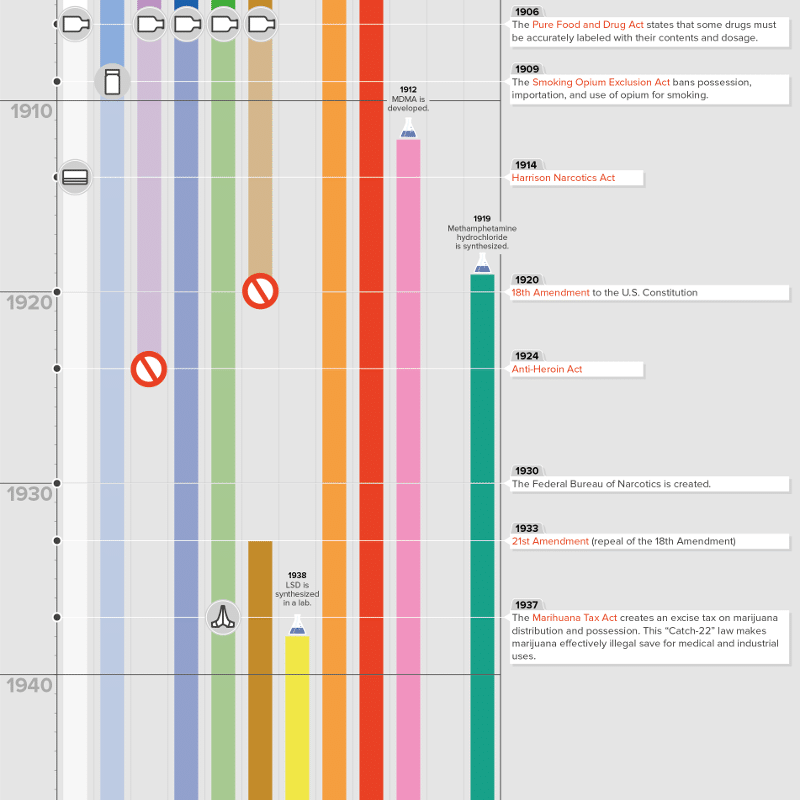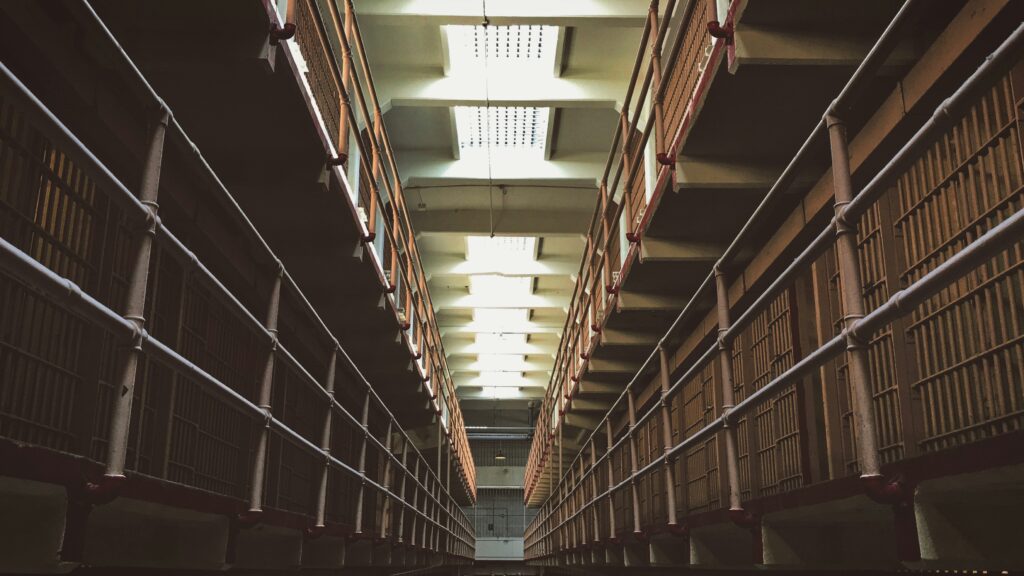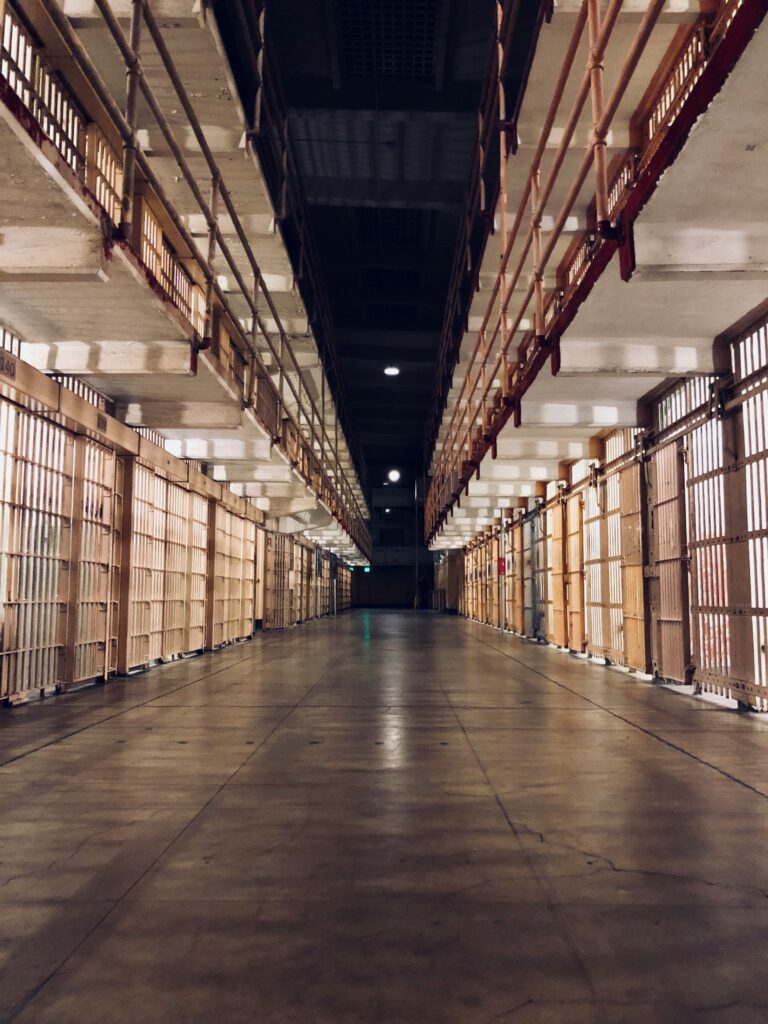The same tinctures once freely sold off of carts now may lead to years of imprisonment in harsh conditions in America. Why? When was the “war on drugs”? How old is it, and how long has it been going on? There’s been a long, strange, and complicated history of drugs in America. The timeline shows the shaky history of drug use and when some common drugs became illegal. Once, alcohol was considered far more problematic than weed. Fentanyl, which is now causing an epidemic of overdoses in the U.S., is less harshly regulated than the popular ’60s psychedelic drug LSD, which you can’t fatally overdose on. Considering all of this, the history of drugs in America is particularly bizarre. Check out our “war on drugs” history to see how recent some of these federal bans are.
A U.S. Drug Legislation Timeline
It’s strange to think about, but the airplane is technically older than active federal prohibition of drugs in the U.S.! The Wright brothers took off in 1903, and the first nationwide attempt to control ingredients didn’t happen until 1906. The very ancient-seeming “war on drugs” didn’t truly begin until a key piece of legislation passed in 1970. We’re going to quickly take a look at both before and during the U.S. war on drugs, a history that doesn’t go as far back as one might imagine. Check out U.S. drug policy history and how it’s changed over the years.

Infographic Embed Code
<a href="https://theweedblog.com/history/illegal-drugs-timeline"><img src="https://theweedblog.com/wp-content/uploads/illegal-drugs-timeline-4_65per_compressed.png" alt="Illegal Drugs: A Timeline of the Federal Legality of 12 Drugs in the United States - TheWeedBlog.com - Infographic" title="Illegal Drugs: A Timeline of the Federal Legality of 12 Drugs in the United States - TheWeedBlog.com - Infographic"></a><br><a href="https://theweedblog.com" alt="TheWeedBlog.com" title="TheWeedBlog.com">By TheWeedBlog.com</a>Before the “War on Drugs”
- 1860s: Medicine is somewhat of a free-for-all, with “snake oil salesmen” selling cures containing alcohol and cocaine. It’s not until this decade that efforts are made to regulate medicines or “poisonous” materials.
- 1875: The first-ever drug control law is passed in San Francisco. It’s a city ordinance passed to stop opium dens.
- 1906: The Pure Food and Drug Act, inspired in part by Upton Sinclair’s The Jungle, is passed, creating the Food and Drug Administration. This has very little effect when it comes to banning currently illegal drugs, but the act demands that certain ingredients (alcohol, caffeine, cocaine, heroin, cannabis, and morphine) must be accurately labeled with the content and dosage.
- 1909: Smoking opium is banned except for medical uses with the Smoking Opium Exclusion Act.
- 1914: The Harrison Narcotics Tax Act of 1914 is one of the first massive bans on unlicensed distribution in our timeline of drugs in America. It’s made to regulate opiates and cocaine.
- 1920: The 18th Amendment to the U.S. Constitution prohibits the sale of alcohol and kick-starts the U.S. Prohibition era. (See the timeline.) Spoiler alert: It doesn’t work out.
- 1924: A federal ban on heroin is enacted with the Anti-Heroin Act.
- 1933: The 21st Amendment repeals the 18th, making alcohol legal again. (We told you it wouldn’t work out.)
- 1937: The Marihuana Tax Act is created to place a tax on cannabis, not ban it, though in practice, the law makes weed illegal. (See the marijuana prohibition section below.)
- 1951: The Boggs Act establishes mandatory minimum sentences, something that will become a huge problem during the “war on drugs.”
- 1956: The Narcotics Control Act increases penalties on marijuana and narcotics trafficking.
- 1965: Hallucinogenic drugs are added in an amendment to the Food, Drug, and Cosmetic Act, but the specific hallucinogenic drugs are not listed.
- 1969: The ruling in Leary v. United States claims that the Marihuana Tax Act violates the Fifth Amendment.
During the “War on Drugs”
- 1970: The Controlled Substances Act (CSA) introduces our modern limits and statutes governing the sale, manufacture, use, possession, and distribution of specific substances, categorized in five “schedules,” with marijuana, LSD, peyote, and others labeled as Schedule I. These Schedule I drugs have “a high potential for abuse,” “no currently acceptable medical use in treatment,” and “a lack of accepted safety for use.”
- 1971: President Richard Nixon coins the term “war on drugs.”
- 1973: The Drug Enforcement Administration (DEA) is established.
- 1978: Peyote use is allowed once again, but only in religious ceremonies via the American Indian Religious Freedom Act.
- 1985: There’s an emergency ban on MDMA, which is given Schedule I status.
- 1986: President Ronald Reagan’s Anti-Drug Abuse Act adds new, more extreme measures to drug enforcement, including new mandatory minimum sentences. It changes the release program from a rehabilitative system to a punitive one. It also authorizes billions of dollars in spending for the domestic “war on drugs.”
- 1998: Twenty-eight years after the CSA passed, the federal government finally commissions a first-ever study of drug policy by the National Research Council.
- 2001: The NRC calls the fact that the federal government didn’t study its own policies “unconscionable.”
- 2012: The first states, Colorado and Washington, legalize marijuana.
When Did the “War on Drugs” Start?
While the term “war on drugs” officially was coined in June of 1971 during a speech by President Nixon, in which he dubbed drug abuse “public enemy number one,” one could safely argue that it began with the Controlled Substances Act of 1970, which began the formal process of scheduling drugs. This “war” continued in full force throughout the 1980s and early ’90s, with millions of dollars being devoted to curbing non-violent drug crimes.
When Did the “War on Drugs” End?
While it has certainly slowed down, with the Obama administration giving very few resources to this fight, one could argue that the war on drugs is still not over. Many organizations, including the American Civil Liberties Union, have been pushing for the government to end the war on drugs. As of now, the question isn’t “when did the ‘war on drugs’ end?” but “when will it end”?
Why should it end? Here are a few sobering “war on drugs” statistics:
- According to CNN, the drug war has cost the United States more than $1 trillion in 40 years.
- According to the Federal Bureau of Prisons, 45.3% of all inmates are in federal prison for drug offenses.
- Nearly half a million people (451,000 people) are locked up for nonviolent drug offenses on any given day.
- It’s not race-blind. Out of the people in prison for drug offenses, nearly 80% of inmates in federal prison and 60% of inmates in state prison are black or Latino.
- Though black and white people use marijuana at comparable rates, black people are four times more likely to be arrested for pot possession.
- Drug imprisonments vary widely by state and don’t correlate with overdoses or use.
A History of Illegal Drugs in America by Drug
Alcohol Prohibition
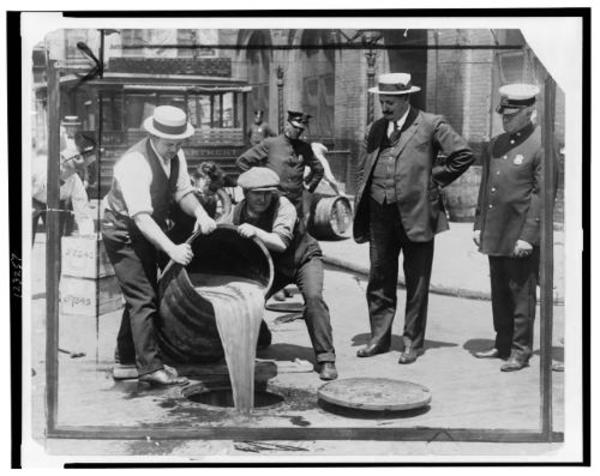
It’s all too easy to look back at the brief era of alcohol prohibition between 1920 and 1933 and side-eye it with a sense of moral superiority. What silly nonsense that was, to think you could pass laws to dictate personal responsibility, to stop the mob, the flappers, and “moral corruption”! But this “noble experiment” lasted 13 years; marijuana prohibition has lasted more than 50. It’s also important not to understate the passion behind the temperance movement (which included people who wanted to eradicate alcohol as much as slavery), the horrible side effects of alcohol, the hope that economic prosperity would come to pass as a result of less drinking, and just how many people have died from drunk driving since alcohol was legalized again in 1933. Alcohol came back during and likely partially due to the Great Depression. Prohibition was a failure for many reasons, but it’s important to understand the issue’s complexity.
The Complex History of Cocaine in the U.S.
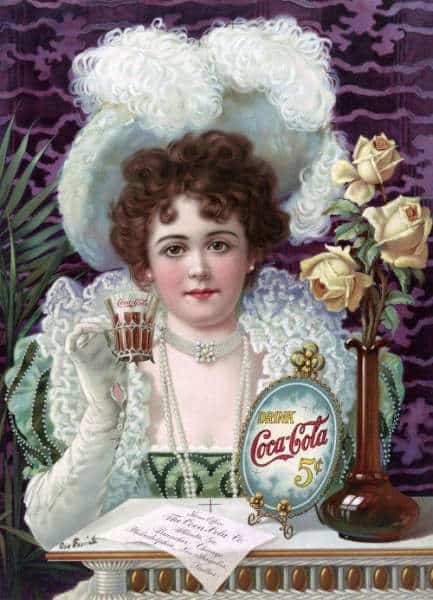
While there’s some truth to the statements that Coca-Cola used to contain cocaine, that it was once frequently prescribed by doctors, and that it was fairly readily available, cocaine was one of the first drugs Americans were worried about in the context of the Pure Food and Drug Act (along with alcohol, heroin, morphine, and cannabis). This law only required that contents of products be labeled. People were also quite worried about caffeine at the time! If you look at cocaine history, the timeline shows that it was not really regulated until the Harrison Narcotics Tax Act of 1914, which required companies and individuals to register in order to sell, distribute, and use cocaine. Its Schedule II status wasn’t earned until the Controlled Substances Act (CSA) during the war on drugs. The timeline shows that this status remained for the next few decades, but what it doesn’t show is the strange distinction between powdered cocaine and crack cocaine even though it’s the same drug, with potentially race-based motivations for worse sentencing for the latter.
History of Marijuana Prohibition
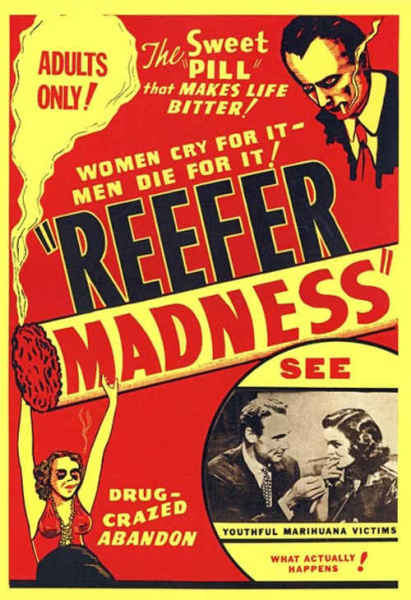
While it may seem like weed has been illegal for ages, if you look back at the history of marijuana, it’s only been banned in the US for a few decades — less than 100 years. Fairly recent monuments like the Empire State Building and Mount Rushmore are technically older than the first-ever law that created a limit on the distribution of marijuana. And that law, the Marihuana Tax Act of 1937, was technically not a federal ban at all but a law that required taxes and licenses. Unfortunately, in order to obtain a tax stamp, individuals needed to present their goods, which was basically a confession to a crime, a catch-22.
With propaganda films like Reefer Madness (1936) (which became a cult classic in its own right), millionaires like Andrew Mellon and Randolph Hearst taking action to protect their financial interests by harming the hemp industry, and growing distrust of the drug overall, one would think that the 1937 law was pretty harsh, but no! During World War II, many farmers were actively encouraged to grow hemp via another propaganda film, Hemp for Victory (1942), as a part of the war effort, and it was done completely legally without changing the law at all.
The Marihuana Tax Act was ruled unconstitutional by the courts in 1969 in Leary v. United States because the law forced one to incriminate oneself to comply with it.
So when did marijuana become illegal in the U.S.? It’s a bit upsetting to realize this, but it’s only been a Schedule I drug since 1970. The Controlled Substances Act (CSA) of 1970 created the modern federal U.S. drug policy by using formal scheduling to control drugs, and cannabis was ranked as more dangerous than cocaine or fentanyl.
Since then, 47 out of 50 states have introduced laws that legalize weed at least in some form, including for medicinal purposes, but the CSA still stands, making it technically still illegal federally. While the history of weed is complicated, its prohibition has only lasted 50 years … at least, so far.
The Prohibition of Opium, Heroin, Morphine, and Fentanyl

From very early on, the U.S. government was fairly wary of opiates and opioids, with some of the first anti-drug laws combating opium and heroin. The Smoking Opium Exclusion Act (1909) effectively banned opium for smoking but was also tinged with anti-immigrant bias in San Francisco and New York City. The Anti-Heroin Act (1924) outlawed what President Herbert Hoover would later call a “menace to society.” But opiate drugs like morphine have been vitally important to medicine, and doctors have almost always had a tendency to over-prescribe the popular painkillers. In this category, only heroin has a complete, Schedule I ban, while fentanyl and related synthetics have lower levels of restriction despite having caused nearly 28,400 deaths in 2017.
The History of Ecstasy (MDMA)
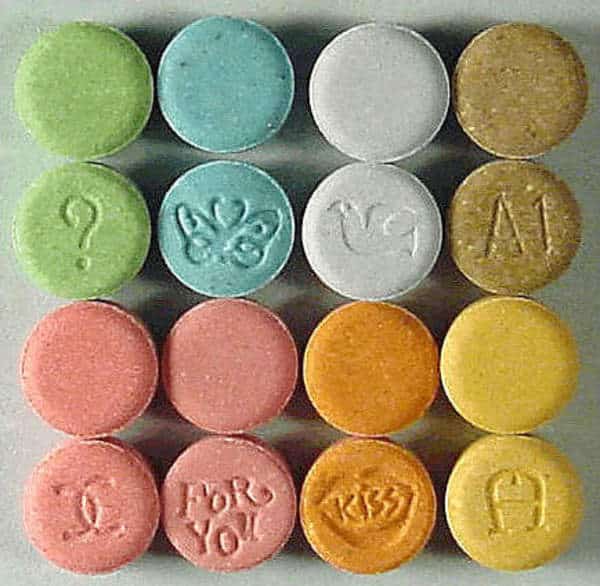
MDMA is another bizarre case in the history of drugs in America. At one point, 3,4-Methylenedioxymethamphetamine was exceedingly popular among psychotherapists, especially marriage counselors. It was called the “yuppie psychedelic” by the San Francisco Chronicle. It was later rushed into Schedule I status during the war on drugs. Despite its ban in 1985, the drug still became popular as a party drug.
Because actual studies of it were very rare, there was an intense lack of information, and several urban legends popped up about Ecstasy. A history timeline will show that the drug’s peak popularity hit in the early 2000s, which is also when Dr. George A. Ricaurte, an expert cited in the war on drugs and one of the only scientists allowed to touch MDMA, falsified his data in a primate study published in 2002 by accidentally switching vials. (Two of his primates died from overdosing on methamphetamine, which is ironically a Schedule II drug.)
Partially due to Dr. Ricaurte’s work, partially due to inaccurate propaganda, and partially due to the lack of credible information, during that time, many people believed that Ecstasy would create holes in the brain, that it could cause Parkinson’s disease, and that it might drain your spinal fluid. While it does have pretty negative effects on the brain that are genuine, including causing severe depressive episodes shortly after use, turning your frontal lobe into Swiss cheese isn’t in the cards. More recently, scientists have been studying whether MDMA has a positive impact on veterans with PTSD.
Banning Peyote, Mescaline, LSD, and Psilocybin
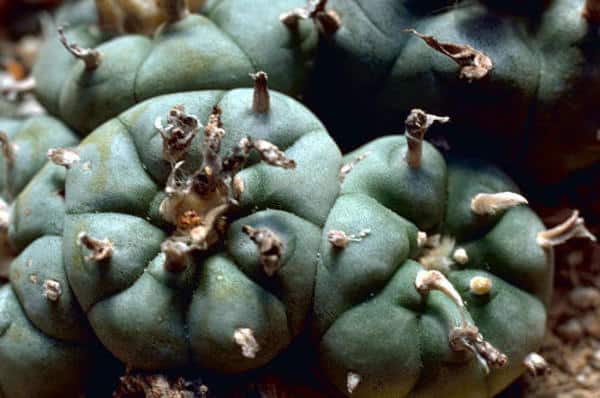
Native American tribes have been using the peyote cactus and its psychoactive ingredient, mescaline, for more than 2,000 years, but in 1970, that stopped being OK for some reason.
Snarky comments aside, the first law affecting this drug was an amendment to the Food, Drug, and Cosmetic Act of 1965, which vaguely banned “hallucinogenic drugs” while not calling mescaline or psilocybin out by name. They became formally illegal in 1970 with Nixon’s Controlled Substances Act (CSA), and native tribes have been in a legal struggle to assert their religious rights ever since. The CSA took the right to use peyote away, the American Indian Religious Freedom Act allowed for non-drug uses of peyote in religious ceremonies, and then the Supreme Court ruled that the state of Oregon could ban mescaline even in religious ceremonies. The Religious Freedom Restoration Act in 1993 re-affirmed the legality of peyote in religious ceremonies, and in 1997, the Supreme Court ruled that it was a states’-rights issue.
While psilocybin doesn’t have quite the same history and religious significance as peyote, there is some evidence that the Maya and Aztec cultures used it. Psilocybin got caught up in the wave of banning LSD. Drug history is often entangled with racism, but lysergic acid diethylamide (LSD or “acid”) was first made in 1938 by a white man. In the 1950s and ’60s, it was trade-named Delysid, and it wasn’t banned under 1970 under the CSA. This scheduling seems extreme, especially when there have been no recorded cases of dying from a chemical overdose; abusers of LSD can die from accidents or bizarre behavior, like jumping through windows.
The U.S. government hasn’t been particularly good about updating drug laws based on new scientific findings. One might argue that the now-very-complicated process of scheduling drugs may have been originally intended to be more fluid, but with drug overdoses on the rise, mostly due to synthetic opioids and prescription drugs, it’s clear that the current system of harsh sentencing and prohibition as a result of the “war on drugs” isn’t working for most Americans. It’s also important to point out that from snake-oil salesmen to opium dens to peyote rituals to crack cocaine to the disproportionate arrests of black and Latino men for weed possession, racism has frequently been baked into the history of which drugs are legal, entangled in the drug timeline in America.
But America can move forward with a different path. Some cities, like Seattle, are rushing to find new and better alternatives to the “war on drugs” by leveraging public health rather than just criminal justice resources. Learn about why the ACLU is taking such a strong stance on criminal law reform and what you can do to help.

